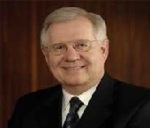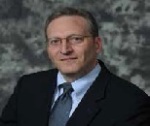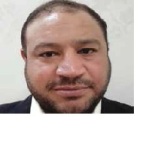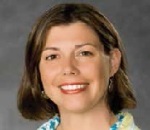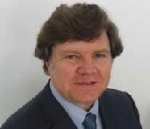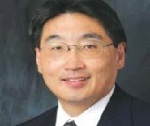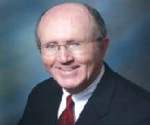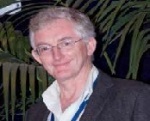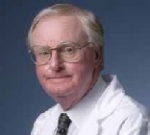Best of 2016: thought leaders honored by health care associations
December 27, 2016
The AAMI Foundation’s Laufman-Greatbatch Award
This is AAMI’s most prestigious award. Named after two pioneers in the field — Harold Laufman, M.D. and Wilson Greatbatch, Ph.D. — this highly-regarded award honors an individual or group that has made a unique and significant contribution to the advancement of health care technology and systems, service, patient care or patient safety.
Candidates must demonstrate a significant, singular and global impact on the advancement of patient care or patient safety through the advancement, development, enhancement or creation of a specific medical device, technology, system or service. Dr. Ary L. Goldberger, of Beth Israel Deaconess Medical Center and Harvard Medical School, and Massachusetts Institute of Technology’s Dr. Roger G. Mark, and George Moody were selected to receive The AAMI Foundation’s 2016 Laufman-Greatbatch Award for their work over the past 20 years to collect and provide access to “big data” through PhysioNet.
PhysioNet is a free collection of recorded physiologic signals and related open-source software intended to stimulate current research and new investigations. Since its launch in 1999 as the outreach component of the Research Resource for Complex Physiologic Signals, the site has provided data that are otherwise inaccessible. PhysioNet’s growing community of more than 40,000 researchers, clinicians, educators, students and medical instrument and software developers around the world retrieve about 700 GB of data per day. Free access to these unique and wide-ranging data and software collections has contributed to the release of an average of more than 130 publications per month.
ACR Gold Medals
The American College of Radiology’s highest honor, the ACR Gold Medal, is awarded annually to radiologists, radiation oncologists, medical physicists and other scientists for their distinguished and extraordinary service to the ACR or to the discipline of radiology. Dr. Walter J. Curran. Jr., FACR, an international expert in advanced lung cancer and malignant brain tumors, is the executive director of the Winship Cancer Institute of Emory University, the Lawrence W. Davis Professor and chair in Emory’s department of radiation oncology, all in Atlanta. A Georgia Research Alliance Eminent Scholar and Chair in Cancer Research, he is also a group chairman of NRG Oncology, an NCIsupported cancer network group administered in part by the ACR. Responsible for defining a universally-adopted staging system for patients with malignant glioma, Curran was the first radiation oncologist to serve as director of a National Cancer Institute-designated cancer center.
Dr. Lawrence P. Davis, FACR, whose clinical interest is nuclear radiology, serves as vice chair and program director of the departments of radiology at North Shore University Hospital, Manhasset, N.Y., and Long Island Jewish Medical Center, New Hyde Park, NY, and as director of special projects for the office of academic affairs at Hofstra/Northwell School of Medicine, Hempstead, N.Y. A professor of radiology at the Hofstra/Northwell School of Medicine, Davis has been active in organized radiology and radiological education. He has served as ACR’s vice president and chair of its Commission on Education as well as chair of the Radiology Residency Review Committee and president of the Association of Program Directors in Radiology.
Dr. Charles D. Williams, FACR, was clinical fellow and instructor in pediatric radiology at the University of Florida College of Medicine until he began practice with Radiology Associates of Tallahassee in 1974. He is affiliated with Capital Regional Medical Center and Tallahassee Memorial Healthcare Hospital. Williams, who specializes in pediatric radiology and breast and diagnostic imaging, served on nearly 50 commission and committee positions in the ACR, including vice president; a member of the Board of Chancellors and Executive Committee; and chair of the Commission on Human Resources. He previously received the Florida Radiological Society Gold Medal, and the annual FRS legacy lecture was named the Charles D. Williams Legacy Lecture.
AHRA Gold Awards
The award is the highest honor AHRA can bestow upon its members. It is given to members who have made significant contributions to the association and, thus, to the profession of health care administration. Nominations for the Gold Award come from the membership and any member may nominate a candidate. All members of AHRA are eligible for award consideration.
Carlos Vasquez, CRA, FAHRA, has been an active AHRA member since 1994. He earned his CRA in 2003 and achieved Fellow status in 2008. Vasquez has raised his hand for many roles within AHRA. Vasquez has been a design team member (Electronic Imaging Design Team co-chair 2002, Annual Meeting Design Team 2002, 2003), a Partners in Learning host (2006, 2007, 2008, 2009), an organizational liaison on behalf of AHRA (HP 2007, 2008, 2009, 2010, 2011), part of the member survey task force (2009), an FPI volunteer (2008), part of two strategic planning committees (2009, 2010), served on the Education Foundation Annual Appeal Committee (2011, 2012) and has been part of the Nominations Committee (Chair 2014, currently serving on the 2016 committee).
Vasquez was elected to the AHRA Board of Directors in 2005. He served as a director until elected president-elect in 2011. Vasquez served as a Class I director on the Education Foundation Board from 2011-2014. Soon after his board role was completed, Vasquez joined the Regulatory Affairs Committee where he remains an active and committed member. Beyond his numerous volunteer activities, Vasquez has been a speaker at the annual meeting (2007, 2008, 2009, 2014) and Spring Conference (2088, 2009). His column “Succession Planning: A Different Leadership Yardstick” (July-August 2009) won the 2010 Radiology Management Editorial Award for Outstanding Column. In 2002, he was recognized with the Award for Excellence.
Melody Mulaik, CRA, FAHRA, joined AHRA in 2001, earned her CRA in 2012 and achieved Fellow status in 2013. Mulaik’s commitment to the association and to advancing the profession of medical imaging is obvious. As president of Coding Strategies Inc., Mulaik has used her coding expertise to elevate the professions of radiology and health care administration, much to the benefit of AHRA members. Her annual coding seminars are among the highest-attended webinars offered by AHRA. Mulaik authored chapters for Financial Management in Radiology (both editions) and has been a popular speaker at the AHRA Annual Meeting and Spring/Fall Conferences since 2003. Not only has Mulaik’s Radiology Management Coding column been a prominent journal feature since 2005, but she has written over 100 RM articles since 2002! In 2007, “Coding: May I Take Your Order Please?” (September October 2006) received the Radiology Management Editorial Award for Outstanding Column.
Most recently Mulaik has been the driving force behind AHRA’s increased regulatory presence. She spearheaded the creation of the Regulatory Affairs Committee and now serves as the committee’s vice chair. Mulaik has also served as the AHRA liaison to ACR for many years. Mulaik served on the AHRA Board of Directors from 2012-2015. She served on the Executive Committee in 2012 and was a CRA item writer in 2014 and 2016.
The ARRS Gold Medal
The ARRS Gold Medal is the American Roentgen Ray Society’s highest honor, awarded to recipients for distinguished service to radiology. Two recipients were named this year. Dr. Thomas H. Berquist is professor of radiology at the Mayo Clinic College of Medicine. He received his M.D. degree from Washington University School of Medicine and completed his internship and residency in diagnostic radiology at the Mayo Graduate School of Medicine. He joined the staff in diagnostic radiology at Mayo Clinic Rochester in 1977 and served as the department vice chair from 1986 to 1990. He moved to the Mayo Clinic in Jacksonville, Florida, in 1990 and became chair of the department of radiology, a position he held until 1999.
During his tenure as chair, he was instrumental in implementing the automated radiology practice for digital imaging. During his career, Berquist has been a member or chair of more than 50 Mayo Clinic committees. He has held significant positions in several professional organizations, including ARRS, the American College of Radiology, Radiological Society of North America and Society of Skeletal Radiology. In 2006, he was appointed to the board of trustees of the American Board of Radiology. In 2008, he was named editor in chief of the AJR. Berquist is an accomplished author of 36 radiology textbooks, more than 200 book chapters and well over 100 peer-reviewed articles.
Charles E. Kahn Jr. is professor and vice-chairman of radiology at the University of Pennsylvania, and senior fellow of Penn’s Institute for Biomedical Informatics and the Leonard Davis Institute of Health Economics. He earned his bachelor’s degree in mathematics and his master’s degree in computer sciences from the University of Wisconsin and received his M.D. degree from the University of Illinois. He completed his radiology residency at the University of Chicago. Kahn received the Association of University Radiologists Konica Visiting Scientist Award, the 1993 ARRS Scholarship and a Whitaker Foundation Research Award.
He received the Radiology Editor’s Recognition Award seven times and the Radiological Society of North America Honored Educator Award. He has served as assistant editor of AJR and associate editor of Radiology and has been elected fellow of the American College of Radiology and the Society for Imaging Informatics in Medicine (SIIM). He is a past ARRS president, DICOM Standards Committee co-chair, SIIM director-at-large and founding co-director of the Interdisciplinary Doctoral Program in Biomedical Informatics at the University of Wisconsin–Milwaukee. Kahn has published more than 100 peer-reviewed journal articles, authored more than 175 scientific presentations and given more than 80 invited lectures.
Jean I. Widger Distinguished Author Award
The award honors the best peer-reviewed articles published in ASRT’s scientific journals. The award is named after longtime Radiologic Technology editor Jean I. Widger. Dr. Haney Alsleem, M.Sc.(MI), B.Sc., and Dr. Robert Davidson, M.App. Sc.(MI), B.Bus., FIR, earned the Widger award for their article “Radiographers’ Ability to Detect Low-Contrast Detail in Digital Radiography Systems,” which was published in the September/October 2015 issue of Radiologic Technology. Alsleem is assistant professor of medical imaging for the College of Applied Medical Sciences, University of Dammam, in Saudi Arabia. Alsleem is involved with radiation dose and image quality optimization in medical imaging equipment, including computed tomography and digital radiography. Davidson is the inaugural professor of medical imaging in the Faculty of Health, University of Canberra, in Australia. His research focuses on dose and image quality in CT and digital image processing in medical imaging. Their study used a low contrast detail phantom to evaluate radiographers’ ability to detect low-contrast detail using various digital planar radiographic systems. Compared with the results of analyzer software, the study found that radiographers performed significantly worse than the computerized software in determining low-contrast detail in planar radiographic images. Because radiographers are responsible for image quality optimization, the researchers concluded that additional training might improve radiographers’ ability to detect low-contrast detail in direct radiography systems.
Harold Silverman Distinguished Author Award
The award is named in honor of radiation therapist Harold Silverman, an advocate for accreditation of radiation therapy educational programs. This award also honors the best peer-reviewed articles published in ASRT’s Radiation Therapist.
Dr. Timmerie F. Cohen, R.T.(R)(T), CMD; Dr. Jeffrey S. Legg, Ph.D., R.T.(R)(CT)(QM), FASRT; and Dr. Melanie C. Dempsey, R.T.(R) (T), CMD, FAAMD, earned the Silverman award for their article, “The Effect of Vertical Off-Centering on Breast Dose During CT Simulation in Accelerated Partial Breast Irradiation Planning,” which was published in the fall 2015 issue of Radiation Therapist. All of the authors work for Virginia Commonwealth University Department of Radiation Sciences in Richmond, Virginia. Cohen is assistant professor and clinical coordinator of radiation therapy for the School of Allied Health Professions. Legg is associate professor and chair of the department. He also is associate editor for the Americas for Radiography. Dempsey is the radiation therapy program director for the School of Allied Health Professions.
Their study sought to determine whether vertical off-centering during CT simulation of accelerated partial breast irradiation influences breast dose. Using an adult anthropomorphic phantom, the researchers placed thermoluminescent dosimeters in various locations and depths in a phantom’s breast tissue. The study concluded that limiting CT simulation procedures in favor of nonionizing imaging studies, such as ultrasonography, and proper CT optimization that includes properly centering patients, can reduce radiation dose to breast tissue.
ASTRO Gold Medal
ASTRO’s Gold Medal, first awarded in 1977, is bestowed annually on up to three ASTRO members who have made outstanding contributions to the field of radiation oncology, including work in research, clinical care, teaching and service. Including this year’s awardees, only 78 of ASTRO’s more than 10,000 members have received the Gold Medal award. Candidates must be nominated by one active member of ASTRO and receive letters of support from two additional active members of ASTRO, detailing the nominee’s impact on the advancement of radiation oncology. Nominees may be from any of the scientific disciplines represented in ASTRO, including radiation oncology, biology and physics.
Dr. Benedick A. Fraass, Ph.D., FASTRO, has dedicated his career to advancing the science of radiation treatment planning and delivery, with accomplishments that include developing three-dimensional treatment planning for routine clinical use, validating advanced uses of computer-controlled radiotherapy and optimizing planning and delivery systems that allow more conformal and dose-escalated radiation doses while reducing the impact on nearby healthy tissue. Fraass serves as vice-chair for research as well as professor and director of medical physics in the department of radiation oncology at Cedars-Sinai Medical Center in Los Angeles. He also holds an appointment as health sciences professor in the department of radiation oncology at the University of California Los Angeles. Before moving to the West Coast, Fraass spent 27 years at the University of Michigan, where he led the radiation oncology department’s physics group and helped to create and then elevate the program to national prominence. Fraass was named the inaugural Allen S. Lichter Professor of Radiation Oncology at Michigan and remains an emeritus professor with the program.
Fraass’ work has enhanced the accuracy and effectiveness of radiation therapy (RT) for scores of patients facing a number of cancer types, including diseases in sites such as the liver and lung that may be difficult to treat. He and his group led efforts in the 1980s to understand and implement three-dimensional planning for radiation treatment, and pioneered the introduction and validation of computer-controlled radiation delivery systems in the 1990s. As one of Fraass’ letters of support noted, clinical trials under his leadership have pioneered the “ability to combine technical and clinical research toward the goal of tailoring each treatment course in an optimal fashion to suit individual patients through their entire treatment.”
Concurrent with his work in tumor visualization and radiation treatment planning, Fraass was, and continues to be, instrumental in several patient safety initiatives, including founding the Radiation Oncology Safety Stakeholders Initiative and leading the development of the ASTRO Safety White Papers. Fraass is the current co-chair of ASTRO’s Integrating Healthcare Enterprise – Radiation Oncology (IHE-RO) Committee, which guides efforts to improve interoperability among the multiple technologies involved in treating patients with RT. He also serves on the Radiation Oncology Healthcare Advisory Council (RO-HAC), which is associated with the Radiation Oncology Incident Learning System (RO-ILS). Fraass’ record of service to the medical physics and radiation oncology communities crosses multiple organizations, initiatives and achievements.
He has served on more than two dozen study sections for the National Cancer Institute and either organized or participated in more than 50 workshops, panels and symposia for scientific and professional organizations. Since joining ASTRO in 1984, Fraass has also participated extensively in teaching activities at the ASTRO Annual Meeting, delivering lectures on topics such as treatment optimization, quality assurance and patient safety. Fraass earned a Bachelor of Science in physics from Stanford University in Palo Alto, California, as well as a Master’s degree and Doctorate in physics from the University of Illinois, Urbana-Champaign. He also completed a fellowship in radiation oncology at the National Institutes of Health prior to joining the Michigan faculty.
Dr. Christopher G. Willett, FASTRO, has improved the lives of many patients with gastrointestinal and other cancers through a career that has brought achievements in a number of interwoven areas. As one of Dr. Willett’s nominating letters explained, he is “a compassionate radiation oncologist fully committed to providing the very best possible care to patients, an innovative translational researcher who has made seminal contributions to the field, and a committed teacher, mentor and leader, whose tireless service has enriched the field of radiation oncology.” Willett is the chair and professor of radiation oncology for the Duke University Medical Center in Durham, North Carolina.
He has served as director for clinical research and numerous other leadership roles with the Duke Cancer Institute. Under his leadership at Duke, the department’s clinical and physics faculty has doubled. He has developed a comprehensive division of medical physics, including a graduate program. And the clinical services have expanded to seven facilities in North Carolina and Virginia. Willett also established a department-supported clinical trial recruitment program that accrues 150 to 180 patients each year to investigator-initiated trials. Before his move to North Carolina, Willett rose from assistant to full professor of radiation oncology at the Massachusetts General Hospital (MGH) and Harvard Medical School in Boston in just over a decade. While at Harvard, Willett also served as director of the Gastrointestinal Cancer Center and clinical director of radiation oncology at MGH and began his extensive involvement with the Radiation Therapy Oncology Group (RTOG).
In a span of nearly 30 years he has served as chair of the RTOG Gastrointestinal Cancer Committee and investigator for a number of trials in gastrointestinal malignancy. Willett’s contributions to clinical and translational research are many, whether pioneering intraoperative radiation therapy (IORT) to treat rectal and pancreatic cancers or demonstrating the potential of RT combined with anti-angiogenic therapy to fight a range of cancer types. For example, in 2004 he published a Nature Medicine article that has been cited more than 1,800 times, reporting an innovative trial combining preoperative RT and fluorouracil together with the anti-angiogenic antibody bevacizumab.
Willett’s relationship with ASTRO began during his medical training at MGH, when he won the Society’s annual Resident Essay Award. He has represented ASTRO as chair of both the steering and scientific program committees for the multidisciplinary Gastrointestinal Cancer Symposium, and was named an ASTRO Fellow in 2011. Willett also spent several years as a senior editor focused on GI cancer for ASTRO’s International Journal of Radiation Oncology • Biology • Physics (Red Journal).
Willett received both his medical degree and Bachelor of Science degree from Tufts University in Boston. At Tufts, Willett happened to overlap with his father, who he names as the strongest influence on his decision to pursue this field. The senior Dr. (Bernard) Willett, while in his late 50s, left a successful practice in surgical oncology to pursue a career in radiation oncology, beginning with a residency in the same medical school where the junior Dr. Willett would soon matriculate. From his father, Willett says he learned “how valuable radiation therapy could be in helping patients.” When asked to reflect on his career, Willett is quick to name the family members, mentors, colleagues and students who helped drive and support him, expressing gratitude for their “positive influence” on his life and work. These include many individuals with whom he worked during his residency and clinical research fellowship at MGH in Boston, in addition to his year as a surgical intern at Vanderbilt University.
Dr. Anthony L. Zietman, FASTRO, has contributed to the science and practice of radiation oncology through decades of influential research on genitourinary (GU) cancers, active mentorship of future practitioners and faculty members and thoughtful leadership at the helm of scientific journals and meetings in oncology. As one of his letters of support extolled, Zietman’s contributions to the field of radiation oncology are “important, sustained and wide-ranging,” and he is seen as “a consummate clinician, an outstanding teacher and mentor, and an innovative clinical scientist.”
In 1986, Zietman joined Harvard Medical School as a research fellow and 30 years later, he is Harvard’s Jenot and William Shipley Professor of Radiation Oncology, and director of the school’s Radiation Oncology Residency Program. Zietman has also treated patients as a radiation oncologist at Massachusetts General Hospital since 1991. “Conscience-based care” is how Zietman describes the model of patient care he strives to practice and promote throughout the field. “We should practice with our conscience and from the evidence,” he said in a recent interview, stressing the importance for clinicians to couple “a devotion to evidence” with the requirement that they “treat patients with what they need, rather than what we need.”
Similarly, his research often considers the value, as well as the effectiveness, of cancer treatment. He has attempted, for example, to clarify whether or not proton therapy fosters superior outcomes compared to other therapies for localized prostate cancer. He has strongly advocated that those with the lowest risk form of this disease be spared from treatment altogether. Zietman has led multiple clinical trials examining the efficacy of therapy in GU cancers, including the use of androgen deprivation or radiation dose escalation for localized prostate cancer and chemo-radiation in bladder cancer. Zietman’s dedication to improving patient care can be seen in the ways he integrates research with service. When the NCI initiated its GU Protocol Steering Committee, Zietman was named its co-chair for Radiation Oncology, a role he continues today as he and the committee help coordinate NCI’s clinical trials effort for GU cancers. Zietman also helped establish the multidisciplinary GU Cancer Symposium, a joint effort of ASTRO, the Society for Urologic Oncology and the American Society for Clinical Oncology. He has been integral in helping write multiple national guidelines for prostate and bladder cancer treatment and editorials to give perspective on treatments new and old.
Since being named editor-in-chief of ASTRO’s flagship journal, the International Journal of Radiation Oncology • Biology • Physics, in 2011, Zietman has made strides in diversifying the journal’s editorial board and editorial focus while simultaneously elevating the caliber and reputation of the journal. Zietman’s leadership with the Red Journal has proved a natural continuation of his service to ASTRO. After leading the program committee for ASTRO’s annual meeting and leading ASTRO’s Education Council for four years, he was elected president and chair of the society by its membership. Zietman credits his time with ASTRO’s board of directors as the place where he learned the powerful role of policy in shaping health outcomes, and the ability of specialty societies to influence these policies.
When asked what drew him to the specialty, Zietman is quick to thank the mentors, including clinicians and scholars in both the U.S. and the U.K., who supported his career and, as he says jokingly, “have a lot to answer for.” Zietman earned a medical degree from the University of London, as well as a Bachelor of Arts degree from Oxford University. He completed multiple residencies and fellowships, including internal medicine at the Middlesex and Westminster hospitals in London, radiation oncology at Massachusetts General Hospital in Boston and clinical oncology at the Middlesex and Mount Vernon hospitals in London.
RSNA Gold Medals
In a tradition that originated in 1919, Gold Medals are presented each year to individuals who have rendered exemplary service to the science of radiology and who have received unanimous approval by the RSNA board of directors. Gold Medal awards are RSNA’s highest honor. This year the organization recognized three individuals. An internationally-recognized expert in the field of imaging informatics, Dr. Paul J. Chang was a pioneer in creating rapid methods of moving digital radiology images, and spearheaded numerous research and development projects related to imaging informatics and enterprise-wide informatics challenges.
Chang’s early work in workstation design has resulted in presentation and navigation models that are widely used by the majority of picture archiving and communication systems (PACS). While at the University of Iowa, he established and evaluated one of the first ultrasound rural teleradiology networks to provide primary interpretation. Chang co-invented a novel lossless wavelet-based image distribution mechanism, dynamic transfer syntax (DTS). This technology was subsequently commercialized by the creation of Stentor PACS, which was later acquired by Philips Medical Systems. Several hundred hospitals worldwide use this PACS system.
Chang was an early advocate for deep and granular information technology (IT) system interoperability to support data-driven informatics workflow orchestration in radiology. He has led the development of one of the world’s first service-oriented architecture (SOA) implementations within a health care enterprise at the University of Chicago. Chang has demonstrated that this SOA approach can be leveraged to improve efficiency and quality in image acquisition, interpretation and results communication. Active in the application of informatics approaches to radiology education, Chang’s research group was one of the first to describe, implement and evaluate the use of simulation in radiology resident education. Under his leadership and in collaboration with RSNA, RSNA Diagnosis Live, a novel cloud-based interactive educational platform featuring gamification and deep analytics, was developed. Diagnosis Live continues to be a very popular part of the RSNA annual meeting and is being used in residency programs worldwide.
Chang is professor and vice-chairman of radiology informatics at the University of Chicago School of Medicine. He also serves as medical director of enterprise imaging and of SOA infrastructure at University of Chicago Hospitals. He received his undergraduate degree from Harvard University and his medical degree from Stanford University. Concurrent with his medical school training, he also received his Master of Science degree in engineering-economic systems from Stanford. Chang completed his residency and fellowship training in diagnostic radiology at Stanford University Hospital. Chang has been a member of the RSNA Radiology Informatics Committee (RIC), American College of Radiology (ACR) Informatics Committee and the ACR Commission on Clinical Research and Information Technology. He has served as a member of the ACR Council Steering Committee and Editorial Board of the Journal of the American College of Radiology (JACR).
He serves as an informatics consultant to the RSNA for the RadSCOPE electronic education initiative. Dr. Chang has published more than 70 peer-reviewed articles, 11 book chapters, 99 abstracts and has been awarded six patents. He has given more than 500 invited lectures worldwide and has served as course director and/or faculty for more than 200 courses for RSNA and for the Society for Imaging Informatics in Medicine (SIIM) in PACS and radiology informatics. He presented the 2012 New Horizons Lecture at the RSNA annual meeting. In 2002, Chang was named as one of the “Top 20 Most Influential People in Radiology” by Diagnostic Imaging. In 2005, he was inducted as a Fellow to the College of the Society for Computer Applications in Radiology (SCAR/SIIM). In 2010, he was named as one of the “25 Most Influential People in Imaging” by RT Image.
A distinguished leader in health care delivery and medical education, Dr. Burton P. Drayer is internationally known for his research using anatomic, physiologic and functional imaging of the aging brain. He was the first to define the normal and abnormal presence of brain iron using MRI. His research interests also include neurodegenerative disorders, brain infarction, xenon-enhanced CT for measuring regional cerebral blood flow, MR angiography, multiple sclerosis and intrathecal contrast media toxicity. Drayer is CEO of the Mount Sinai Doctors Faculty Practice and dean for Clinical Affairs, the Icahn School of Medicine at Mount Sinai Medical Center in New York City. Drayer also serves as the Dr. Charles M. and Marilyn Newman Professor and system chair of the Department of Radiology, Icahn School of Medicine, and as executive vice president for Risk, the Mount Sinai Medical Center.
He served as president of the Mount Sinai Hospital from November 2003 to September 2008. Drayer, who served as RSNA president in 2011, received his undergraduate degree in political science from the University of Pennsylvania in Philadelphia. In 1971, he received his medical degree from Chicago Medical School and went on to complete a medical internship and neurology residency at the University of Vermont in Burlington. Drayer completed his radiology residency followed by a neuroradiology fellowship at the University of Pittsburgh Medical Center. Drayer’s academic appointments began in 1977 at the University of Pittsburgh Health Center. From 1979 to 1986, Drayer was at Duke University Medical Center in Durham, N.C., where he became professor of radiology and assistant professor of medicine (neurology).
In 1986, he was appointed chairman of the Division of Neuroimaging Research-Education at the Barrow Neurological Institute in Phoenix, Ariz., where he remained until 1995. Drayer then moved to The Mount Sinai Medical Center where he practices today. Since 1979, Drayer has reviewed manuscripts for nine medical journals, including Radiology, and was editor of Neuroimaging Clinics of North America from 1991 to 2005. He has authored or coauthored nearly 200 journal articles, 41 book chapters and two books. He is also a sought-after lecturer both nationally and internationally, having given more than 300 invited lectures and speeches.
Drayer’s many accolades include the Cornelius G. Dyke Award from the American Society of Neuroradiology (ASNR) and the Distinguished Service Award from the American Board of Radiology (ABR). He received the ASNR gold medal in 2011. An RSNA member since 1980, Drayer serves as chair of the RSNA Research & Education (R&E) Foundation Board of Trustees. He served as RSNA first vice president in 2003. Drayer has been an active volunteer, serving as chair of the Public Information Committee, a member of the Public Information Advisors Network and the R&E Foundation’s Public Relations Committee. He moderated the RSNA Image Interpretation Session in 2004. Drayer was elected to the RSNA board of directors in December 2003, was liaison for the annual meeting and technology until 2008 and served as chairman of the board and president-elect in 2009 and 2010, respectively.
Drayer is a past president of the ASNR, as well as a founder of the Neuroradiology Education and Research Foundation of ASNR. Drayer is a fellow of both the American College of Radiology (ACR) and American Academy of Neurology, and a past president of the New York Roentgen Society. He is an active member in many neurology and radiology organizations, including the ACR, where he was chair of the Committee on Appropriateness Criteria’s Panel on Neurological Imaging from 1994 to 2003. A world-renowned abdominal radiologist, Dr. Robert J. Stanley became a leading authority in the early development of body CT imaging, and has been a mentor to future generations of radiologists.
Stanley grew up in New Jersey, where he earned his undergraduate degree at St. Peter’s College in Jersey City, New Jersey. He then headed west and earned his medical degree at St. Louis University, where he also completed a medicine internship and a year of surgery residency before completing his radiology residency. More recently, he received a Master of Science degree in health administration at the University of Alabama at Birmingham (UAB), where he is professor emeritus in the Department of Radiology.
Stanley got his start in academic radiology at the Mallinckrodt Institute of Radiology (MIR), Washington University, St. Louis, and he joined the faculty after completing his radiology residency. He spent the next 11 years at MIR as director of the abdominal radiology section before leaving to serve as professor and chair of the Department of Radiology at the University of Alabama School of Medicine in Birmingham. Stanley’s involvement with whole-body CT began in earnest in the fall of 1975 when EMI Corp. collaborated with Washington University and the Mayo Clinic in Rochester, Minn., for the implementation and evaluation of its first two whole body CT scanners in the United States. Given the opportunity, along with Stuart S. Sagel, M.D., to head up the newly created body CT facility, Stanley soon became an authority in the new imaging field.
Just prior to leaving MIR, Dr. Stanley and his co-authors, Dr. Sagel and Dr. Joseph K. T. Lee, completed the first edition of their landmark CT textbook, Computed Body Tomography with MRI Correlation, currently in its fourth edition. Over his 32-year tenure as chair of the Department of Radiology at UAB, Stanley saw the department grow in size and stature. During this time, he remained active in all aspects of abdominal radiology, and also served as a member of the Board of Chancellors of the American College of Radiology (ACR) for seven years, chairing the Commission on Standards and Accreditation, as well as being elected vice president of ACR. Under his chairmanship, 55 standards (now called practice guidelines) were created.
A prolific author of more than 180 scientific publications, Stanley also served as editor-in-chief of the American Journal of Roentgenology (AJR). Stanley continued to serve on the clinical faculty at UAB, primarily working with residents in their body CT education until July 2014, when he retired from the clinical faculty. Stanley has served in a leadership role in numerous radiology organizations. He is a founder of both the Society of Uroradiology and the Society of Computed Body Tomography and Magnetic Resonance (SCBT-MR) and served as president of both societies. In 2014, he was awarded the Walter B. Cannon Medal for distinguished contributions to GI radiology by the Society of Abdominal Radiology. And in 2014, he was awarded the first SCBT-MR gold medal for significant contributions to CT imaging. Stanley was an advisory editor and associate editor on the Radiology editorial board, and has also served on the RSNA Public Information Advisors Network.
Roger A. Bauman, MD Award
The Roger A. Bauman, M.D. Award is presented for the best student paper each year at the annual meeting. This award was named to honor Dr. Bauman’s distinguished career in radiological informatics research and practice, and his status as founding editor of the Journal of Digital Imaging. Dr. Judy W. Gichoya is a medical doctor specializing in radiology, with training and more than six years’ experience in informatics. As well as winning the SIIM 2016 Roger A. Bauman Best Student Paper Award, she also won the SIIM 2016 New Investigator Travel Award. She has worked with multiple organizations for global health in Kenya, Ethiopia, Uganda, Colombia and Tanzania, implementing mhealth and ehealth solutions targeting patient care. Her passion is to create health care ecosystems through a social entrepreneurship model that combines her medical and technology skills, and improving people’s lives by tackling poverty.
Most Downloaded Paper
Authors: Sian Taylor-Phillips, Marcus C. Elze, Elizabeth A Krupinski, Kathryn Dennick, Alaster G. Gale, Aileen Clarke, Claudia Mellow-Thoms
Title: Retrospective Review of the Drop in Observer Detection Performance Over Time in Lesion-enriched Experimental Studies
Dr. Sian Taylor-Phillips’ research focus is health screening and diagnosis, in particular breast cancer screening. Taylor-Phillips applies a range of quantitative research methods primarily to questions about test performance and selection, quality assurance and improvement. Taylor-Phillips leads the Heath Screening masters module, which is a collaboration with the U.K. National Screening Committee. Taylor-Phillips is currently undertaking an NIHR postdoctoral fellowship leading a multicenter randomized controlled trial of a software intervention designed to improve cancer detection performance in breast cancer screening. This work builds on research investigating fatigue and patterns of performance in breast cancer screening, which was part of a Wellcome Trust Value in People Fellowship. Prior to this, Taylor Phillips undertook research about decision-making in the NHS, in particular which services to fund. Taylor-Phillips’ first degree and masters was in physics at the University of Warwick. After some time working in industry, Taylor-Phillips undertook a masters in ergonomics at Loughborough University, researching the ergonomic issues associated with guide dogs and travel on the London Underground.
The Ph.D. work involved investigating the ergonomic and performance issues associated with the presentation of prior mammograms in breast cancer screening. Dr. Elizabeth Krupinski is an experimental psychologist with research interests in medical image perception, observer performance, medical decision-making and human factors as they pertain to radiology and telemedicine. The goal of her research is to improve our understanding of the perceptual and cognitive mechanisms underlying the interpretation of medical images in order to reduce errors, improve training and optimize the reading environment, thereby improving patient care and outcomes. Krupinski is a past SIIM chair.
Best Paper Award
Title: Consistency and Standardization of Color in Medical Imaging: a Consensus Report
Authors: Aldo Badano, Craig Revie, Andrew Casertano, Wei-Chung Cheng, Phil Green, Tom Kimpe, Elizabeth Krupinski, Christye Sisson, Stein Skrøvseth, Darren Treanor, Paul Boynton, David Clunie, Michael J. Flynn, Tatsuo Heki, Stephen Hewitt, Hiroyuki Homma, Andy Masia, Takashi Matsui, Balázs Nagy, Masahiro Nishibori, John Penczek, Thomas Schopf, Yukako Yagi, Hideto Yokoi
Dr. Aldo Badano is the laboratory leader for imaging physics in the Division of Imaging and Applied Mathematics, Office of Science and Engineering Laboratories, Center for Devices and Radiological Health, U.S. Food and Drug Administration. Badano leads a program on the characterization, modeling and assessment of medical image acquisition and display devices using advanced experimental and computational methods. Badano is also an adjunct faculty member of the Graduate Program in Bioengineering at the University of Maryland, College Park. He received a Ph.D. degree in nuclear engineering and a MEng in radiological health engineering from the University of Michigan in 1999 and 1995, and a ChemEng degree from the Universidad de la República, Montevideo, Uruguay, in 1992. He serves as associate editor for several scientific journals and as a reviewer of technical grants for DOD and NIH. Badano has authored more than 150 publications and a tutorial textbook on medical displays.
Dr. David Clunie is a radiologist, medical informaticist, DICOM open source software author and editor of the DICOM standard. At SIIM 2016 he accepted the award for most downloaded JDI paper 2015, as a major contributor. He was also awarded SIIM fellowship designation for his significant contributions to the field of imaging informatics and enterprise image management. He is the proprietor of PixelMed Publishing, a company formed for the purpose of publishing educational material about DICOM and related subjects, as well as development of open source and custom software, and consulting and training in the field, and expert witness services in patent litigation.
He was the CTO of CoreLab Partners (formerly RadPharm), until it was acquired by BioClinica, and prior to that was medical imaging products director of development at ComView Corporation, director of medical imaging technology at Quintiles Intelligent Imaging and before that, lead designer for DICOM Standardization at GE Medical Systems. Current special interests include standard reporting of quantitative imaging results, radiation dose structured reporting, standardization of imaging procedure codes and ontologies, modeling of imaging procedures and de-identification of imaging data for secondary reuse.
Paul C. Aebersold Award
The Paul C. Aebersold Award is named after a pioneer in the biologic and medical application of radioactive materials and the first director of the Atomic Energy Commission’s Division of Isotope Development. The award recognizes outstanding achievement in basic science applied to nuclear medicine and was first presented in 1973. The SNMMI Committee on Awards selects the recipient. Dr. Peter S. Conti, FACNP, FACR, professor of radiology, pharmaceutical sciences and biomedical engineering, and director of the Molecular Imaging Center, Keck School of Medicine, University of Southern California, Los Angeles, has been named the 2016 recipient of the prestigious Paul C. Aebersold Award.
A tenured professor at the University of Southern California, Conti has served as director of the university’s Molecular Imaging Center (formerly the Positron Imaging Science Center and Clinic) since its inception in 1991. His research focuses on development of novel diagnostic imaging agents for oncology applications. He pioneered the use of PET imaging in the understanding and characterization of cancer metabolism and gene expression, and he has focused on the discovery and clinical translation of novel PET imaging agents for in vivo cancer diagnosis, evaluation of metastatic disease potential and assessment of response to therapy.
Conti received his medical degree from Cornell University Medical College and his doctorate in biophysics from Cornell University Graduate School of Medical Sciences, Sloan-Kettering Division, New York, N.Y. He completed his residency in diagnostic radiology and fellowship in nuclear medicine at Johns Hopkins Medical Institutions, Baltimore, and interned in the Department of Surgery at St. Luke’s Hospital in New York. Conti is board certified in both diagnostic radiology and nuclear medicine. He is a fellow of the American College of Radiology and the American College of Nuclear Medicine Physicians. He has published more than 300 peer-reviewed scientific articles and abstracts in the field of molecular imaging. Conti is a past president of the Society of Nuclear Medicine and remains active in the society (now called the Society of Nuclear Medicine and Molecular Imaging), serving on a number of committees, including government and regulatory affairs related to the development of molecular imaging technology and its applications in medicine.
Georg Charles de Hevesy Nuclear Medicine Pioneer Award
Each year, SNMMI presents the Georg Charles de Hevesy Nuclear Medicine Pioneer Award to an individual for outstanding contributions to the field of nuclear medicine. De Hevesy received the 1943 Nobel Prize in chemistry for his work in determining the absorption, distribution, metabolism and elimination of radioactive compounds in the human body. His work led to the foundation of nuclear medicine as a tool for diagnosis and therapy, and he is considered to be one of the fathers of nuclear medicine. SNMMI has given the de Hevesy Award every year since 1960 to honor groundbreaking discoveries and inventions in the field of nuclear medicine.
Dr. Ross McDougall, MB, ChB, professor emeritus of radiology and medicine at Stanford University, has been named this year’s recipient of the Georg Charles de Hevesy Nuclear Medicine Pioneer Award for his contributions to nuclear medicine. McDougall has been associated with Stanford University Medical School from 1972, the first two years as a fellow and subsequently as full-time faculty. In 1989, he took over directorship of the thyroid clinic. McDougall was involved in both the Medical School and the hospital. He held numerous positions of importance at those institutions, including president of the medical center — the first faculty member elected to this post. He was director of the Nuclear Medicine Residency Program for 25 years. Since retiring as director of the thyroid clinic in 2008, he has been an active emeritus professor. McDougall conducted laboratory and clinical research and published more than 160 peer-reviewed papers and 110 book chapters, reviews and editorials. He authored or coauthored three textbooks on thyroid disease. He was appointed to the American Board of Nuclear Medicine, and he subsequently chaired the board for two years. He was vice chair of the Residency Review Committee in Nuclear Medicine. He was also a governor of the American Board of Internal Medicine for three years. He was president of the Western Regional Chapter of the Society of Nuclear Medicine and Molecular Imaging.
This is AAMI’s most prestigious award. Named after two pioneers in the field — Harold Laufman, M.D. and Wilson Greatbatch, Ph.D. — this highly-regarded award honors an individual or group that has made a unique and significant contribution to the advancement of health care technology and systems, service, patient care or patient safety.
Candidates must demonstrate a significant, singular and global impact on the advancement of patient care or patient safety through the advancement, development, enhancement or creation of a specific medical device, technology, system or service. Dr. Ary L. Goldberger, of Beth Israel Deaconess Medical Center and Harvard Medical School, and Massachusetts Institute of Technology’s Dr. Roger G. Mark, and George Moody were selected to receive The AAMI Foundation’s 2016 Laufman-Greatbatch Award for their work over the past 20 years to collect and provide access to “big data” through PhysioNet.
PhysioNet is a free collection of recorded physiologic signals and related open-source software intended to stimulate current research and new investigations. Since its launch in 1999 as the outreach component of the Research Resource for Complex Physiologic Signals, the site has provided data that are otherwise inaccessible. PhysioNet’s growing community of more than 40,000 researchers, clinicians, educators, students and medical instrument and software developers around the world retrieve about 700 GB of data per day. Free access to these unique and wide-ranging data and software collections has contributed to the release of an average of more than 130 publications per month.
ACR Gold Medals
The American College of Radiology’s highest honor, the ACR Gold Medal, is awarded annually to radiologists, radiation oncologists, medical physicists and other scientists for their distinguished and extraordinary service to the ACR or to the discipline of radiology. Dr. Walter J. Curran. Jr., FACR, an international expert in advanced lung cancer and malignant brain tumors, is the executive director of the Winship Cancer Institute of Emory University, the Lawrence W. Davis Professor and chair in Emory’s department of radiation oncology, all in Atlanta. A Georgia Research Alliance Eminent Scholar and Chair in Cancer Research, he is also a group chairman of NRG Oncology, an NCIsupported cancer network group administered in part by the ACR. Responsible for defining a universally-adopted staging system for patients with malignant glioma, Curran was the first radiation oncologist to serve as director of a National Cancer Institute-designated cancer center.
Dr. Lawrence P. Davis, FACR, whose clinical interest is nuclear radiology, serves as vice chair and program director of the departments of radiology at North Shore University Hospital, Manhasset, N.Y., and Long Island Jewish Medical Center, New Hyde Park, NY, and as director of special projects for the office of academic affairs at Hofstra/Northwell School of Medicine, Hempstead, N.Y. A professor of radiology at the Hofstra/Northwell School of Medicine, Davis has been active in organized radiology and radiological education. He has served as ACR’s vice president and chair of its Commission on Education as well as chair of the Radiology Residency Review Committee and president of the Association of Program Directors in Radiology.
Dr. Charles D. Williams, FACR, was clinical fellow and instructor in pediatric radiology at the University of Florida College of Medicine until he began practice with Radiology Associates of Tallahassee in 1974. He is affiliated with Capital Regional Medical Center and Tallahassee Memorial Healthcare Hospital. Williams, who specializes in pediatric radiology and breast and diagnostic imaging, served on nearly 50 commission and committee positions in the ACR, including vice president; a member of the Board of Chancellors and Executive Committee; and chair of the Commission on Human Resources. He previously received the Florida Radiological Society Gold Medal, and the annual FRS legacy lecture was named the Charles D. Williams Legacy Lecture.
AHRA Gold Awards
The award is the highest honor AHRA can bestow upon its members. It is given to members who have made significant contributions to the association and, thus, to the profession of health care administration. Nominations for the Gold Award come from the membership and any member may nominate a candidate. All members of AHRA are eligible for award consideration.
Carlos Vasquez, CRA, FAHRA, has been an active AHRA member since 1994. He earned his CRA in 2003 and achieved Fellow status in 2008. Vasquez has raised his hand for many roles within AHRA. Vasquez has been a design team member (Electronic Imaging Design Team co-chair 2002, Annual Meeting Design Team 2002, 2003), a Partners in Learning host (2006, 2007, 2008, 2009), an organizational liaison on behalf of AHRA (HP 2007, 2008, 2009, 2010, 2011), part of the member survey task force (2009), an FPI volunteer (2008), part of two strategic planning committees (2009, 2010), served on the Education Foundation Annual Appeal Committee (2011, 2012) and has been part of the Nominations Committee (Chair 2014, currently serving on the 2016 committee).
Vasquez was elected to the AHRA Board of Directors in 2005. He served as a director until elected president-elect in 2011. Vasquez served as a Class I director on the Education Foundation Board from 2011-2014. Soon after his board role was completed, Vasquez joined the Regulatory Affairs Committee where he remains an active and committed member. Beyond his numerous volunteer activities, Vasquez has been a speaker at the annual meeting (2007, 2008, 2009, 2014) and Spring Conference (2088, 2009). His column “Succession Planning: A Different Leadership Yardstick” (July-August 2009) won the 2010 Radiology Management Editorial Award for Outstanding Column. In 2002, he was recognized with the Award for Excellence.
Melody Mulaik, CRA, FAHRA, joined AHRA in 2001, earned her CRA in 2012 and achieved Fellow status in 2013. Mulaik’s commitment to the association and to advancing the profession of medical imaging is obvious. As president of Coding Strategies Inc., Mulaik has used her coding expertise to elevate the professions of radiology and health care administration, much to the benefit of AHRA members. Her annual coding seminars are among the highest-attended webinars offered by AHRA. Mulaik authored chapters for Financial Management in Radiology (both editions) and has been a popular speaker at the AHRA Annual Meeting and Spring/Fall Conferences since 2003. Not only has Mulaik’s Radiology Management Coding column been a prominent journal feature since 2005, but she has written over 100 RM articles since 2002! In 2007, “Coding: May I Take Your Order Please?” (September October 2006) received the Radiology Management Editorial Award for Outstanding Column.
Most recently Mulaik has been the driving force behind AHRA’s increased regulatory presence. She spearheaded the creation of the Regulatory Affairs Committee and now serves as the committee’s vice chair. Mulaik has also served as the AHRA liaison to ACR for many years. Mulaik served on the AHRA Board of Directors from 2012-2015. She served on the Executive Committee in 2012 and was a CRA item writer in 2014 and 2016.
The ARRS Gold Medal
The ARRS Gold Medal is the American Roentgen Ray Society’s highest honor, awarded to recipients for distinguished service to radiology. Two recipients were named this year. Dr. Thomas H. Berquist is professor of radiology at the Mayo Clinic College of Medicine. He received his M.D. degree from Washington University School of Medicine and completed his internship and residency in diagnostic radiology at the Mayo Graduate School of Medicine. He joined the staff in diagnostic radiology at Mayo Clinic Rochester in 1977 and served as the department vice chair from 1986 to 1990. He moved to the Mayo Clinic in Jacksonville, Florida, in 1990 and became chair of the department of radiology, a position he held until 1999.
During his tenure as chair, he was instrumental in implementing the automated radiology practice for digital imaging. During his career, Berquist has been a member or chair of more than 50 Mayo Clinic committees. He has held significant positions in several professional organizations, including ARRS, the American College of Radiology, Radiological Society of North America and Society of Skeletal Radiology. In 2006, he was appointed to the board of trustees of the American Board of Radiology. In 2008, he was named editor in chief of the AJR. Berquist is an accomplished author of 36 radiology textbooks, more than 200 book chapters and well over 100 peer-reviewed articles.
Charles E. Kahn Jr. is professor and vice-chairman of radiology at the University of Pennsylvania, and senior fellow of Penn’s Institute for Biomedical Informatics and the Leonard Davis Institute of Health Economics. He earned his bachelor’s degree in mathematics and his master’s degree in computer sciences from the University of Wisconsin and received his M.D. degree from the University of Illinois. He completed his radiology residency at the University of Chicago. Kahn received the Association of University Radiologists Konica Visiting Scientist Award, the 1993 ARRS Scholarship and a Whitaker Foundation Research Award.
He received the Radiology Editor’s Recognition Award seven times and the Radiological Society of North America Honored Educator Award. He has served as assistant editor of AJR and associate editor of Radiology and has been elected fellow of the American College of Radiology and the Society for Imaging Informatics in Medicine (SIIM). He is a past ARRS president, DICOM Standards Committee co-chair, SIIM director-at-large and founding co-director of the Interdisciplinary Doctoral Program in Biomedical Informatics at the University of Wisconsin–Milwaukee. Kahn has published more than 100 peer-reviewed journal articles, authored more than 175 scientific presentations and given more than 80 invited lectures.
Jean I. Widger Distinguished Author Award
The award honors the best peer-reviewed articles published in ASRT’s scientific journals. The award is named after longtime Radiologic Technology editor Jean I. Widger. Dr. Haney Alsleem, M.Sc.(MI), B.Sc., and Dr. Robert Davidson, M.App. Sc.(MI), B.Bus., FIR, earned the Widger award for their article “Radiographers’ Ability to Detect Low-Contrast Detail in Digital Radiography Systems,” which was published in the September/October 2015 issue of Radiologic Technology. Alsleem is assistant professor of medical imaging for the College of Applied Medical Sciences, University of Dammam, in Saudi Arabia. Alsleem is involved with radiation dose and image quality optimization in medical imaging equipment, including computed tomography and digital radiography. Davidson is the inaugural professor of medical imaging in the Faculty of Health, University of Canberra, in Australia. His research focuses on dose and image quality in CT and digital image processing in medical imaging. Their study used a low contrast detail phantom to evaluate radiographers’ ability to detect low-contrast detail using various digital planar radiographic systems. Compared with the results of analyzer software, the study found that radiographers performed significantly worse than the computerized software in determining low-contrast detail in planar radiographic images. Because radiographers are responsible for image quality optimization, the researchers concluded that additional training might improve radiographers’ ability to detect low-contrast detail in direct radiography systems.
Harold Silverman Distinguished Author Award
The award is named in honor of radiation therapist Harold Silverman, an advocate for accreditation of radiation therapy educational programs. This award also honors the best peer-reviewed articles published in ASRT’s Radiation Therapist.
Dr. Timmerie F. Cohen, R.T.(R)(T), CMD; Dr. Jeffrey S. Legg, Ph.D., R.T.(R)(CT)(QM), FASRT; and Dr. Melanie C. Dempsey, R.T.(R) (T), CMD, FAAMD, earned the Silverman award for their article, “The Effect of Vertical Off-Centering on Breast Dose During CT Simulation in Accelerated Partial Breast Irradiation Planning,” which was published in the fall 2015 issue of Radiation Therapist. All of the authors work for Virginia Commonwealth University Department of Radiation Sciences in Richmond, Virginia. Cohen is assistant professor and clinical coordinator of radiation therapy for the School of Allied Health Professions. Legg is associate professor and chair of the department. He also is associate editor for the Americas for Radiography. Dempsey is the radiation therapy program director for the School of Allied Health Professions.
Their study sought to determine whether vertical off-centering during CT simulation of accelerated partial breast irradiation influences breast dose. Using an adult anthropomorphic phantom, the researchers placed thermoluminescent dosimeters in various locations and depths in a phantom’s breast tissue. The study concluded that limiting CT simulation procedures in favor of nonionizing imaging studies, such as ultrasonography, and proper CT optimization that includes properly centering patients, can reduce radiation dose to breast tissue.
ASTRO Gold Medal
ASTRO’s Gold Medal, first awarded in 1977, is bestowed annually on up to three ASTRO members who have made outstanding contributions to the field of radiation oncology, including work in research, clinical care, teaching and service. Including this year’s awardees, only 78 of ASTRO’s more than 10,000 members have received the Gold Medal award. Candidates must be nominated by one active member of ASTRO and receive letters of support from two additional active members of ASTRO, detailing the nominee’s impact on the advancement of radiation oncology. Nominees may be from any of the scientific disciplines represented in ASTRO, including radiation oncology, biology and physics.
Dr. Benedick A. Fraass, Ph.D., FASTRO, has dedicated his career to advancing the science of radiation treatment planning and delivery, with accomplishments that include developing three-dimensional treatment planning for routine clinical use, validating advanced uses of computer-controlled radiotherapy and optimizing planning and delivery systems that allow more conformal and dose-escalated radiation doses while reducing the impact on nearby healthy tissue. Fraass serves as vice-chair for research as well as professor and director of medical physics in the department of radiation oncology at Cedars-Sinai Medical Center in Los Angeles. He also holds an appointment as health sciences professor in the department of radiation oncology at the University of California Los Angeles. Before moving to the West Coast, Fraass spent 27 years at the University of Michigan, where he led the radiation oncology department’s physics group and helped to create and then elevate the program to national prominence. Fraass was named the inaugural Allen S. Lichter Professor of Radiation Oncology at Michigan and remains an emeritus professor with the program.
Fraass’ work has enhanced the accuracy and effectiveness of radiation therapy (RT) for scores of patients facing a number of cancer types, including diseases in sites such as the liver and lung that may be difficult to treat. He and his group led efforts in the 1980s to understand and implement three-dimensional planning for radiation treatment, and pioneered the introduction and validation of computer-controlled radiation delivery systems in the 1990s. As one of Fraass’ letters of support noted, clinical trials under his leadership have pioneered the “ability to combine technical and clinical research toward the goal of tailoring each treatment course in an optimal fashion to suit individual patients through their entire treatment.”
Concurrent with his work in tumor visualization and radiation treatment planning, Fraass was, and continues to be, instrumental in several patient safety initiatives, including founding the Radiation Oncology Safety Stakeholders Initiative and leading the development of the ASTRO Safety White Papers. Fraass is the current co-chair of ASTRO’s Integrating Healthcare Enterprise – Radiation Oncology (IHE-RO) Committee, which guides efforts to improve interoperability among the multiple technologies involved in treating patients with RT. He also serves on the Radiation Oncology Healthcare Advisory Council (RO-HAC), which is associated with the Radiation Oncology Incident Learning System (RO-ILS). Fraass’ record of service to the medical physics and radiation oncology communities crosses multiple organizations, initiatives and achievements.
He has served on more than two dozen study sections for the National Cancer Institute and either organized or participated in more than 50 workshops, panels and symposia for scientific and professional organizations. Since joining ASTRO in 1984, Fraass has also participated extensively in teaching activities at the ASTRO Annual Meeting, delivering lectures on topics such as treatment optimization, quality assurance and patient safety. Fraass earned a Bachelor of Science in physics from Stanford University in Palo Alto, California, as well as a Master’s degree and Doctorate in physics from the University of Illinois, Urbana-Champaign. He also completed a fellowship in radiation oncology at the National Institutes of Health prior to joining the Michigan faculty.
Dr. Christopher G. Willett, FASTRO, has improved the lives of many patients with gastrointestinal and other cancers through a career that has brought achievements in a number of interwoven areas. As one of Dr. Willett’s nominating letters explained, he is “a compassionate radiation oncologist fully committed to providing the very best possible care to patients, an innovative translational researcher who has made seminal contributions to the field, and a committed teacher, mentor and leader, whose tireless service has enriched the field of radiation oncology.” Willett is the chair and professor of radiation oncology for the Duke University Medical Center in Durham, North Carolina.
He has served as director for clinical research and numerous other leadership roles with the Duke Cancer Institute. Under his leadership at Duke, the department’s clinical and physics faculty has doubled. He has developed a comprehensive division of medical physics, including a graduate program. And the clinical services have expanded to seven facilities in North Carolina and Virginia. Willett also established a department-supported clinical trial recruitment program that accrues 150 to 180 patients each year to investigator-initiated trials. Before his move to North Carolina, Willett rose from assistant to full professor of radiation oncology at the Massachusetts General Hospital (MGH) and Harvard Medical School in Boston in just over a decade. While at Harvard, Willett also served as director of the Gastrointestinal Cancer Center and clinical director of radiation oncology at MGH and began his extensive involvement with the Radiation Therapy Oncology Group (RTOG).
In a span of nearly 30 years he has served as chair of the RTOG Gastrointestinal Cancer Committee and investigator for a number of trials in gastrointestinal malignancy. Willett’s contributions to clinical and translational research are many, whether pioneering intraoperative radiation therapy (IORT) to treat rectal and pancreatic cancers or demonstrating the potential of RT combined with anti-angiogenic therapy to fight a range of cancer types. For example, in 2004 he published a Nature Medicine article that has been cited more than 1,800 times, reporting an innovative trial combining preoperative RT and fluorouracil together with the anti-angiogenic antibody bevacizumab.
Willett’s relationship with ASTRO began during his medical training at MGH, when he won the Society’s annual Resident Essay Award. He has represented ASTRO as chair of both the steering and scientific program committees for the multidisciplinary Gastrointestinal Cancer Symposium, and was named an ASTRO Fellow in 2011. Willett also spent several years as a senior editor focused on GI cancer for ASTRO’s International Journal of Radiation Oncology • Biology • Physics (Red Journal).
Willett received both his medical degree and Bachelor of Science degree from Tufts University in Boston. At Tufts, Willett happened to overlap with his father, who he names as the strongest influence on his decision to pursue this field. The senior Dr. (Bernard) Willett, while in his late 50s, left a successful practice in surgical oncology to pursue a career in radiation oncology, beginning with a residency in the same medical school where the junior Dr. Willett would soon matriculate. From his father, Willett says he learned “how valuable radiation therapy could be in helping patients.” When asked to reflect on his career, Willett is quick to name the family members, mentors, colleagues and students who helped drive and support him, expressing gratitude for their “positive influence” on his life and work. These include many individuals with whom he worked during his residency and clinical research fellowship at MGH in Boston, in addition to his year as a surgical intern at Vanderbilt University.
Dr. Anthony L. Zietman, FASTRO, has contributed to the science and practice of radiation oncology through decades of influential research on genitourinary (GU) cancers, active mentorship of future practitioners and faculty members and thoughtful leadership at the helm of scientific journals and meetings in oncology. As one of his letters of support extolled, Zietman’s contributions to the field of radiation oncology are “important, sustained and wide-ranging,” and he is seen as “a consummate clinician, an outstanding teacher and mentor, and an innovative clinical scientist.”
In 1986, Zietman joined Harvard Medical School as a research fellow and 30 years later, he is Harvard’s Jenot and William Shipley Professor of Radiation Oncology, and director of the school’s Radiation Oncology Residency Program. Zietman has also treated patients as a radiation oncologist at Massachusetts General Hospital since 1991. “Conscience-based care” is how Zietman describes the model of patient care he strives to practice and promote throughout the field. “We should practice with our conscience and from the evidence,” he said in a recent interview, stressing the importance for clinicians to couple “a devotion to evidence” with the requirement that they “treat patients with what they need, rather than what we need.”
Similarly, his research often considers the value, as well as the effectiveness, of cancer treatment. He has attempted, for example, to clarify whether or not proton therapy fosters superior outcomes compared to other therapies for localized prostate cancer. He has strongly advocated that those with the lowest risk form of this disease be spared from treatment altogether. Zietman has led multiple clinical trials examining the efficacy of therapy in GU cancers, including the use of androgen deprivation or radiation dose escalation for localized prostate cancer and chemo-radiation in bladder cancer. Zietman’s dedication to improving patient care can be seen in the ways he integrates research with service. When the NCI initiated its GU Protocol Steering Committee, Zietman was named its co-chair for Radiation Oncology, a role he continues today as he and the committee help coordinate NCI’s clinical trials effort for GU cancers. Zietman also helped establish the multidisciplinary GU Cancer Symposium, a joint effort of ASTRO, the Society for Urologic Oncology and the American Society for Clinical Oncology. He has been integral in helping write multiple national guidelines for prostate and bladder cancer treatment and editorials to give perspective on treatments new and old.
Since being named editor-in-chief of ASTRO’s flagship journal, the International Journal of Radiation Oncology • Biology • Physics, in 2011, Zietman has made strides in diversifying the journal’s editorial board and editorial focus while simultaneously elevating the caliber and reputation of the journal. Zietman’s leadership with the Red Journal has proved a natural continuation of his service to ASTRO. After leading the program committee for ASTRO’s annual meeting and leading ASTRO’s Education Council for four years, he was elected president and chair of the society by its membership. Zietman credits his time with ASTRO’s board of directors as the place where he learned the powerful role of policy in shaping health outcomes, and the ability of specialty societies to influence these policies.
When asked what drew him to the specialty, Zietman is quick to thank the mentors, including clinicians and scholars in both the U.S. and the U.K., who supported his career and, as he says jokingly, “have a lot to answer for.” Zietman earned a medical degree from the University of London, as well as a Bachelor of Arts degree from Oxford University. He completed multiple residencies and fellowships, including internal medicine at the Middlesex and Westminster hospitals in London, radiation oncology at Massachusetts General Hospital in Boston and clinical oncology at the Middlesex and Mount Vernon hospitals in London.
RSNA Gold Medals
In a tradition that originated in 1919, Gold Medals are presented each year to individuals who have rendered exemplary service to the science of radiology and who have received unanimous approval by the RSNA board of directors. Gold Medal awards are RSNA’s highest honor. This year the organization recognized three individuals. An internationally-recognized expert in the field of imaging informatics, Dr. Paul J. Chang was a pioneer in creating rapid methods of moving digital radiology images, and spearheaded numerous research and development projects related to imaging informatics and enterprise-wide informatics challenges.
Chang’s early work in workstation design has resulted in presentation and navigation models that are widely used by the majority of picture archiving and communication systems (PACS). While at the University of Iowa, he established and evaluated one of the first ultrasound rural teleradiology networks to provide primary interpretation. Chang co-invented a novel lossless wavelet-based image distribution mechanism, dynamic transfer syntax (DTS). This technology was subsequently commercialized by the creation of Stentor PACS, which was later acquired by Philips Medical Systems. Several hundred hospitals worldwide use this PACS system.
Chang was an early advocate for deep and granular information technology (IT) system interoperability to support data-driven informatics workflow orchestration in radiology. He has led the development of one of the world’s first service-oriented architecture (SOA) implementations within a health care enterprise at the University of Chicago. Chang has demonstrated that this SOA approach can be leveraged to improve efficiency and quality in image acquisition, interpretation and results communication. Active in the application of informatics approaches to radiology education, Chang’s research group was one of the first to describe, implement and evaluate the use of simulation in radiology resident education. Under his leadership and in collaboration with RSNA, RSNA Diagnosis Live, a novel cloud-based interactive educational platform featuring gamification and deep analytics, was developed. Diagnosis Live continues to be a very popular part of the RSNA annual meeting and is being used in residency programs worldwide.
Chang is professor and vice-chairman of radiology informatics at the University of Chicago School of Medicine. He also serves as medical director of enterprise imaging and of SOA infrastructure at University of Chicago Hospitals. He received his undergraduate degree from Harvard University and his medical degree from Stanford University. Concurrent with his medical school training, he also received his Master of Science degree in engineering-economic systems from Stanford. Chang completed his residency and fellowship training in diagnostic radiology at Stanford University Hospital. Chang has been a member of the RSNA Radiology Informatics Committee (RIC), American College of Radiology (ACR) Informatics Committee and the ACR Commission on Clinical Research and Information Technology. He has served as a member of the ACR Council Steering Committee and Editorial Board of the Journal of the American College of Radiology (JACR).
He serves as an informatics consultant to the RSNA for the RadSCOPE electronic education initiative. Dr. Chang has published more than 70 peer-reviewed articles, 11 book chapters, 99 abstracts and has been awarded six patents. He has given more than 500 invited lectures worldwide and has served as course director and/or faculty for more than 200 courses for RSNA and for the Society for Imaging Informatics in Medicine (SIIM) in PACS and radiology informatics. He presented the 2012 New Horizons Lecture at the RSNA annual meeting. In 2002, Chang was named as one of the “Top 20 Most Influential People in Radiology” by Diagnostic Imaging. In 2005, he was inducted as a Fellow to the College of the Society for Computer Applications in Radiology (SCAR/SIIM). In 2010, he was named as one of the “25 Most Influential People in Imaging” by RT Image.
A distinguished leader in health care delivery and medical education, Dr. Burton P. Drayer is internationally known for his research using anatomic, physiologic and functional imaging of the aging brain. He was the first to define the normal and abnormal presence of brain iron using MRI. His research interests also include neurodegenerative disorders, brain infarction, xenon-enhanced CT for measuring regional cerebral blood flow, MR angiography, multiple sclerosis and intrathecal contrast media toxicity. Drayer is CEO of the Mount Sinai Doctors Faculty Practice and dean for Clinical Affairs, the Icahn School of Medicine at Mount Sinai Medical Center in New York City. Drayer also serves as the Dr. Charles M. and Marilyn Newman Professor and system chair of the Department of Radiology, Icahn School of Medicine, and as executive vice president for Risk, the Mount Sinai Medical Center.
He served as president of the Mount Sinai Hospital from November 2003 to September 2008. Drayer, who served as RSNA president in 2011, received his undergraduate degree in political science from the University of Pennsylvania in Philadelphia. In 1971, he received his medical degree from Chicago Medical School and went on to complete a medical internship and neurology residency at the University of Vermont in Burlington. Drayer completed his radiology residency followed by a neuroradiology fellowship at the University of Pittsburgh Medical Center. Drayer’s academic appointments began in 1977 at the University of Pittsburgh Health Center. From 1979 to 1986, Drayer was at Duke University Medical Center in Durham, N.C., where he became professor of radiology and assistant professor of medicine (neurology).
In 1986, he was appointed chairman of the Division of Neuroimaging Research-Education at the Barrow Neurological Institute in Phoenix, Ariz., where he remained until 1995. Drayer then moved to The Mount Sinai Medical Center where he practices today. Since 1979, Drayer has reviewed manuscripts for nine medical journals, including Radiology, and was editor of Neuroimaging Clinics of North America from 1991 to 2005. He has authored or coauthored nearly 200 journal articles, 41 book chapters and two books. He is also a sought-after lecturer both nationally and internationally, having given more than 300 invited lectures and speeches.
Drayer’s many accolades include the Cornelius G. Dyke Award from the American Society of Neuroradiology (ASNR) and the Distinguished Service Award from the American Board of Radiology (ABR). He received the ASNR gold medal in 2011. An RSNA member since 1980, Drayer serves as chair of the RSNA Research & Education (R&E) Foundation Board of Trustees. He served as RSNA first vice president in 2003. Drayer has been an active volunteer, serving as chair of the Public Information Committee, a member of the Public Information Advisors Network and the R&E Foundation’s Public Relations Committee. He moderated the RSNA Image Interpretation Session in 2004. Drayer was elected to the RSNA board of directors in December 2003, was liaison for the annual meeting and technology until 2008 and served as chairman of the board and president-elect in 2009 and 2010, respectively.
Drayer is a past president of the ASNR, as well as a founder of the Neuroradiology Education and Research Foundation of ASNR. Drayer is a fellow of both the American College of Radiology (ACR) and American Academy of Neurology, and a past president of the New York Roentgen Society. He is an active member in many neurology and radiology organizations, including the ACR, where he was chair of the Committee on Appropriateness Criteria’s Panel on Neurological Imaging from 1994 to 2003. A world-renowned abdominal radiologist, Dr. Robert J. Stanley became a leading authority in the early development of body CT imaging, and has been a mentor to future generations of radiologists.
Stanley grew up in New Jersey, where he earned his undergraduate degree at St. Peter’s College in Jersey City, New Jersey. He then headed west and earned his medical degree at St. Louis University, where he also completed a medicine internship and a year of surgery residency before completing his radiology residency. More recently, he received a Master of Science degree in health administration at the University of Alabama at Birmingham (UAB), where he is professor emeritus in the Department of Radiology.
Stanley got his start in academic radiology at the Mallinckrodt Institute of Radiology (MIR), Washington University, St. Louis, and he joined the faculty after completing his radiology residency. He spent the next 11 years at MIR as director of the abdominal radiology section before leaving to serve as professor and chair of the Department of Radiology at the University of Alabama School of Medicine in Birmingham. Stanley’s involvement with whole-body CT began in earnest in the fall of 1975 when EMI Corp. collaborated with Washington University and the Mayo Clinic in Rochester, Minn., for the implementation and evaluation of its first two whole body CT scanners in the United States. Given the opportunity, along with Stuart S. Sagel, M.D., to head up the newly created body CT facility, Stanley soon became an authority in the new imaging field.
Just prior to leaving MIR, Dr. Stanley and his co-authors, Dr. Sagel and Dr. Joseph K. T. Lee, completed the first edition of their landmark CT textbook, Computed Body Tomography with MRI Correlation, currently in its fourth edition. Over his 32-year tenure as chair of the Department of Radiology at UAB, Stanley saw the department grow in size and stature. During this time, he remained active in all aspects of abdominal radiology, and also served as a member of the Board of Chancellors of the American College of Radiology (ACR) for seven years, chairing the Commission on Standards and Accreditation, as well as being elected vice president of ACR. Under his chairmanship, 55 standards (now called practice guidelines) were created.
A prolific author of more than 180 scientific publications, Stanley also served as editor-in-chief of the American Journal of Roentgenology (AJR). Stanley continued to serve on the clinical faculty at UAB, primarily working with residents in their body CT education until July 2014, when he retired from the clinical faculty. Stanley has served in a leadership role in numerous radiology organizations. He is a founder of both the Society of Uroradiology and the Society of Computed Body Tomography and Magnetic Resonance (SCBT-MR) and served as president of both societies. In 2014, he was awarded the Walter B. Cannon Medal for distinguished contributions to GI radiology by the Society of Abdominal Radiology. And in 2014, he was awarded the first SCBT-MR gold medal for significant contributions to CT imaging. Stanley was an advisory editor and associate editor on the Radiology editorial board, and has also served on the RSNA Public Information Advisors Network.
Roger A. Bauman, MD Award
The Roger A. Bauman, M.D. Award is presented for the best student paper each year at the annual meeting. This award was named to honor Dr. Bauman’s distinguished career in radiological informatics research and practice, and his status as founding editor of the Journal of Digital Imaging. Dr. Judy W. Gichoya is a medical doctor specializing in radiology, with training and more than six years’ experience in informatics. As well as winning the SIIM 2016 Roger A. Bauman Best Student Paper Award, she also won the SIIM 2016 New Investigator Travel Award. She has worked with multiple organizations for global health in Kenya, Ethiopia, Uganda, Colombia and Tanzania, implementing mhealth and ehealth solutions targeting patient care. Her passion is to create health care ecosystems through a social entrepreneurship model that combines her medical and technology skills, and improving people’s lives by tackling poverty.
Most Downloaded Paper
Authors: Sian Taylor-Phillips, Marcus C. Elze, Elizabeth A Krupinski, Kathryn Dennick, Alaster G. Gale, Aileen Clarke, Claudia Mellow-Thoms
Title: Retrospective Review of the Drop in Observer Detection Performance Over Time in Lesion-enriched Experimental Studies
Dr. Sian Taylor-Phillips’ research focus is health screening and diagnosis, in particular breast cancer screening. Taylor-Phillips applies a range of quantitative research methods primarily to questions about test performance and selection, quality assurance and improvement. Taylor-Phillips leads the Heath Screening masters module, which is a collaboration with the U.K. National Screening Committee. Taylor-Phillips is currently undertaking an NIHR postdoctoral fellowship leading a multicenter randomized controlled trial of a software intervention designed to improve cancer detection performance in breast cancer screening. This work builds on research investigating fatigue and patterns of performance in breast cancer screening, which was part of a Wellcome Trust Value in People Fellowship. Prior to this, Taylor Phillips undertook research about decision-making in the NHS, in particular which services to fund. Taylor-Phillips’ first degree and masters was in physics at the University of Warwick. After some time working in industry, Taylor-Phillips undertook a masters in ergonomics at Loughborough University, researching the ergonomic issues associated with guide dogs and travel on the London Underground.
The Ph.D. work involved investigating the ergonomic and performance issues associated with the presentation of prior mammograms in breast cancer screening. Dr. Elizabeth Krupinski is an experimental psychologist with research interests in medical image perception, observer performance, medical decision-making and human factors as they pertain to radiology and telemedicine. The goal of her research is to improve our understanding of the perceptual and cognitive mechanisms underlying the interpretation of medical images in order to reduce errors, improve training and optimize the reading environment, thereby improving patient care and outcomes. Krupinski is a past SIIM chair.
Best Paper Award
Title: Consistency and Standardization of Color in Medical Imaging: a Consensus Report
Authors: Aldo Badano, Craig Revie, Andrew Casertano, Wei-Chung Cheng, Phil Green, Tom Kimpe, Elizabeth Krupinski, Christye Sisson, Stein Skrøvseth, Darren Treanor, Paul Boynton, David Clunie, Michael J. Flynn, Tatsuo Heki, Stephen Hewitt, Hiroyuki Homma, Andy Masia, Takashi Matsui, Balázs Nagy, Masahiro Nishibori, John Penczek, Thomas Schopf, Yukako Yagi, Hideto Yokoi
Dr. Aldo Badano is the laboratory leader for imaging physics in the Division of Imaging and Applied Mathematics, Office of Science and Engineering Laboratories, Center for Devices and Radiological Health, U.S. Food and Drug Administration. Badano leads a program on the characterization, modeling and assessment of medical image acquisition and display devices using advanced experimental and computational methods. Badano is also an adjunct faculty member of the Graduate Program in Bioengineering at the University of Maryland, College Park. He received a Ph.D. degree in nuclear engineering and a MEng in radiological health engineering from the University of Michigan in 1999 and 1995, and a ChemEng degree from the Universidad de la República, Montevideo, Uruguay, in 1992. He serves as associate editor for several scientific journals and as a reviewer of technical grants for DOD and NIH. Badano has authored more than 150 publications and a tutorial textbook on medical displays.
Dr. David Clunie is a radiologist, medical informaticist, DICOM open source software author and editor of the DICOM standard. At SIIM 2016 he accepted the award for most downloaded JDI paper 2015, as a major contributor. He was also awarded SIIM fellowship designation for his significant contributions to the field of imaging informatics and enterprise image management. He is the proprietor of PixelMed Publishing, a company formed for the purpose of publishing educational material about DICOM and related subjects, as well as development of open source and custom software, and consulting and training in the field, and expert witness services in patent litigation.
He was the CTO of CoreLab Partners (formerly RadPharm), until it was acquired by BioClinica, and prior to that was medical imaging products director of development at ComView Corporation, director of medical imaging technology at Quintiles Intelligent Imaging and before that, lead designer for DICOM Standardization at GE Medical Systems. Current special interests include standard reporting of quantitative imaging results, radiation dose structured reporting, standardization of imaging procedure codes and ontologies, modeling of imaging procedures and de-identification of imaging data for secondary reuse.
Paul C. Aebersold Award
The Paul C. Aebersold Award is named after a pioneer in the biologic and medical application of radioactive materials and the first director of the Atomic Energy Commission’s Division of Isotope Development. The award recognizes outstanding achievement in basic science applied to nuclear medicine and was first presented in 1973. The SNMMI Committee on Awards selects the recipient. Dr. Peter S. Conti, FACNP, FACR, professor of radiology, pharmaceutical sciences and biomedical engineering, and director of the Molecular Imaging Center, Keck School of Medicine, University of Southern California, Los Angeles, has been named the 2016 recipient of the prestigious Paul C. Aebersold Award.
A tenured professor at the University of Southern California, Conti has served as director of the university’s Molecular Imaging Center (formerly the Positron Imaging Science Center and Clinic) since its inception in 1991. His research focuses on development of novel diagnostic imaging agents for oncology applications. He pioneered the use of PET imaging in the understanding and characterization of cancer metabolism and gene expression, and he has focused on the discovery and clinical translation of novel PET imaging agents for in vivo cancer diagnosis, evaluation of metastatic disease potential and assessment of response to therapy.
Conti received his medical degree from Cornell University Medical College and his doctorate in biophysics from Cornell University Graduate School of Medical Sciences, Sloan-Kettering Division, New York, N.Y. He completed his residency in diagnostic radiology and fellowship in nuclear medicine at Johns Hopkins Medical Institutions, Baltimore, and interned in the Department of Surgery at St. Luke’s Hospital in New York. Conti is board certified in both diagnostic radiology and nuclear medicine. He is a fellow of the American College of Radiology and the American College of Nuclear Medicine Physicians. He has published more than 300 peer-reviewed scientific articles and abstracts in the field of molecular imaging. Conti is a past president of the Society of Nuclear Medicine and remains active in the society (now called the Society of Nuclear Medicine and Molecular Imaging), serving on a number of committees, including government and regulatory affairs related to the development of molecular imaging technology and its applications in medicine.
Georg Charles de Hevesy Nuclear Medicine Pioneer Award
Each year, SNMMI presents the Georg Charles de Hevesy Nuclear Medicine Pioneer Award to an individual for outstanding contributions to the field of nuclear medicine. De Hevesy received the 1943 Nobel Prize in chemistry for his work in determining the absorption, distribution, metabolism and elimination of radioactive compounds in the human body. His work led to the foundation of nuclear medicine as a tool for diagnosis and therapy, and he is considered to be one of the fathers of nuclear medicine. SNMMI has given the de Hevesy Award every year since 1960 to honor groundbreaking discoveries and inventions in the field of nuclear medicine.
Dr. Ross McDougall, MB, ChB, professor emeritus of radiology and medicine at Stanford University, has been named this year’s recipient of the Georg Charles de Hevesy Nuclear Medicine Pioneer Award for his contributions to nuclear medicine. McDougall has been associated with Stanford University Medical School from 1972, the first two years as a fellow and subsequently as full-time faculty. In 1989, he took over directorship of the thyroid clinic. McDougall was involved in both the Medical School and the hospital. He held numerous positions of importance at those institutions, including president of the medical center — the first faculty member elected to this post. He was director of the Nuclear Medicine Residency Program for 25 years. Since retiring as director of the thyroid clinic in 2008, he has been an active emeritus professor. McDougall conducted laboratory and clinical research and published more than 160 peer-reviewed papers and 110 book chapters, reviews and editorials. He authored or coauthored three textbooks on thyroid disease. He was appointed to the American Board of Nuclear Medicine, and he subsequently chaired the board for two years. He was vice chair of the Residency Review Committee in Nuclear Medicine. He was also a governor of the American Board of Internal Medicine for three years. He was president of the Western Regional Chapter of the Society of Nuclear Medicine and Molecular Imaging.






